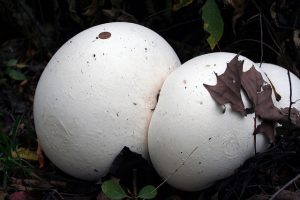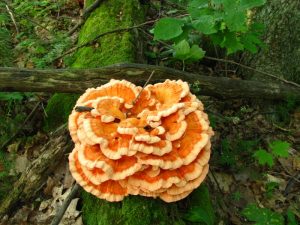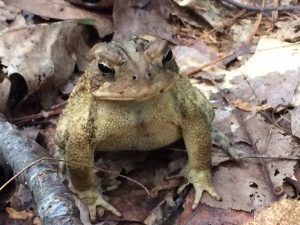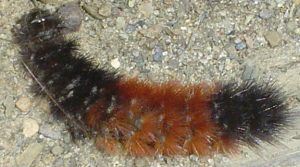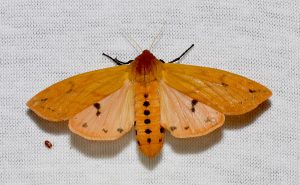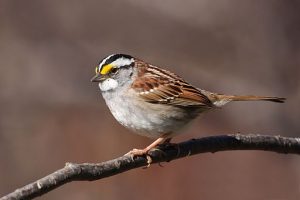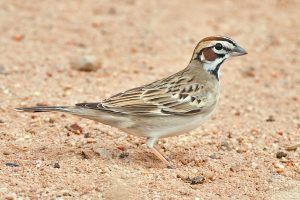Written by Gwyn Loud for the Lincoln Land Conservation Trust. She welcomes your sightings and questions at 781-259-8690 or gwyn_loud@comcast.net.
September was an unusually wet month, and the rainy days have continued into October. Rainfall in Boston for September averages 3.77 inches but by the end of the month we had had a whopping 7.78 inches, with 2.96 inches due to the remnants of Hurricane Florence. As a result of all the rain, plants are flourishing, lawns are bright green, and mushrooms are sprouting all over the place. They come in numerous shapes, sizes and colors and some like the giant puffball, are can be almost as big as a soccer ball. The wet weather has brought out frogs and toads and one can see them on roads at night. I have heard gray tree frogs trilling as well as single notes of spring peepers, which are actually known to call throughout the year, although it is only in the spring that we hear their loud chorus.
Leaves are starting to turn, with maples providing splashes of red and orange to the landscape. Acorns are dropping, crabapples are plentiful, Norway spruces seem to have a bumper crop of cones, and many berries on shrubs are ripening, all important food for wildlife. Flowers still in bloom include goldenrod and asters in colors of white and lavender and a Winter Street resident was pleased to find white turtleheads blooming in the wetlands. On a recent LLCT Fern Walk Ellen and Jim Meadors, the leaders, showed us twelve different species of ferns; their informative handout can be read on the LLCT website.
Perhaps you have noticed a lot of gray squirrels and chipmunks this fall, some, alas, the victims of road kill. The population explosion of small mammals is the result of a huge acorn crop last fall, called a “mast year”, leading to more adults surviving the winter and producing more offspring this spring and summer. In mast years gray squirrels are likely to have two litters of young, rather than just one in years with smaller crops of acorns and other nuts. Of course small rodents are part of the food chain, providing meals for larger mammals such as foxes, fishers, and coyotes, so their populations benefit also. I regularly see does and fawns near our house on Conant Road and another observer notes raccoons feeding nightly on grapes over a trellis. A black bear was reported in a yard on Bedford Road, north of Route 2, on Sept. 21.
Crickets and grasshoppers continue to sing as long as the temperatures are mild. Katydids and snowy tree crickets have been noticeable in the evenings, their regular chirps slowing down as it become cooler. On September 22 a “Bioblitz” was held at Minuteman National Park to find and identify as many species of flora and fauna as possible. Lincoln naturalist Norman Levey focused on recording singing insects such as Say’s trigs, four-spotted tree crickets, and striped ground crickets, all making different sounds. An insect which seems numerous this fall is the woolly bear caterpillar, fuzzy, with black and brown bristles. Folklore says that a wider middle brown section foretells a mild winter. I have seen many with wide brown bands recently, but the Farmer’s Almanac predicts a long cold snowy winter. Time will tell who is right! The woolly bear spends the winter curled up as a larva, unlike most moths, and spins a cocoon in the spring, to hatch as an Isabella tiger moth. Yellowjackets, a type of wasp, are another common fall insect, often attracted to your picnic or to sources of sugar such as rotting apples. Beware- they sting!
The fall bird migration is well underway and a number of warblers and vireos have been spotted passing through, as well as flocks of robins and common grackles. Gray catbirds and Eastern phoebes are still here and a , American pipit, osprey, red-shouldered hawk, American kestrel, six purple finches, and a ruby-crowned kinglet were seen at Drumlin Farm. A spotted sandpiper was feeding by a puddle at the Transfer Station. October is sparrow month: many savannah and chipping sparrows have been reported, as well as the first white-throated sparrows, which will winter here. A lark sparrow, rarer species, was spotted on October 1 in the Van Leer Field at Drumlin Farm. Ron Pittaway, ornithologist in Ontario, writes in his annual Winter Finch Forecast, “This is an irruption (flight) year for winter finches in the East. Cone and birch seed crops are poor to low in most of Ontario and the Northeast (Canada)……. Stock your bird feeders because many birds will have a difficult time finding natural foods this winter. “ The reduced food supply in eastern Canada means that we may see more numbers of species such as red-breasted nuthatches, redpolls, pine siskins and pine grosbeaks.
Pamela Sowizral, who oversees the monitoring of cavity nesting birds at Drumlin Farm, reports that Eastern bluebirds and tree swallows had a very successful nesting season in the many birdboxes. She write ,”bluebirds laid 71 eggs, had 63 chicks, and 59 fledglings (compared to 38 fledglings in 2017). This was also a very good fledge rate with 93% of chicks going on to fledge. Tree swallows laid 57 eggs, hatched 41 chicks, with 40 fledglings – a record number of fledglings for us. I attribute this in part to the absence of a stretch of cool, wet weather during the nesting season which allowed these aerial insectivores to keep up with the food demands of the nestlings.”
In other bird news, watch for the bright white mute swans on Farrar Pond as you drive by on Route 117. Currently there are two resident adults with two adolescent cygnets and four visiting adults.
If you feed the birds, clean your feeders and put them up by the end of October so that our winter resident birds put you on their “restaurant route.”
© Gwyn Loud


